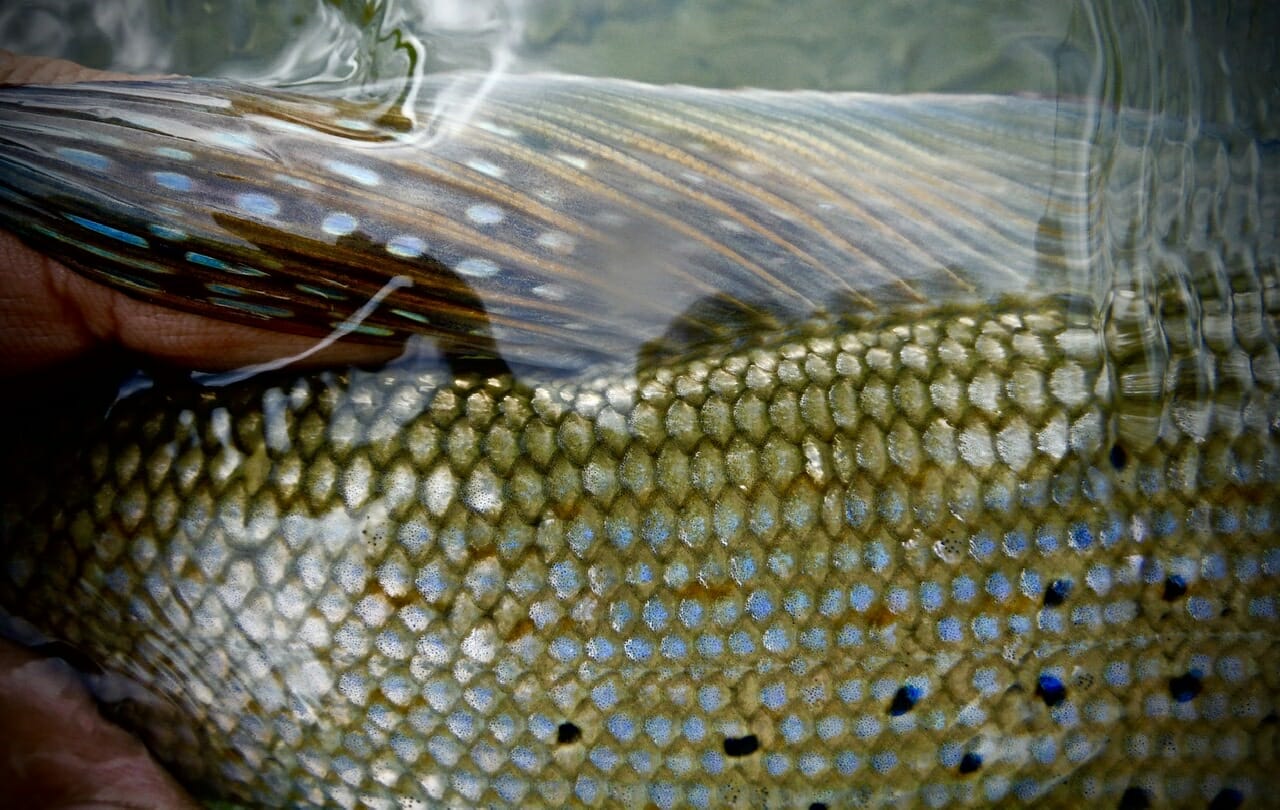Arctic grayling are easily recognized due to their large and colorful dorsal fin. Chris Hunt photo.
Arctic Grayling (Thymallus arcticus)
Species Summary and Status: The Arctic grayling is a cool or cold- freshwater species in the same family (salmonidae) as salmon, trout and whitefish. The defining characteristic of this fish is its large, sail-like dorsal fin.
The Arctic grayling occurs throughout the Arctic as far west as the Kara River in Russia and east to the western shores of Hudson Bay in Canada. They were once common as far south as Michigan and Montana, but the Arctic grayling has almost disappeared from the northern United States because of overfishing, competition from introduced species and habitat loss. Two distinct populations historically inhabited waters in Michigan and Montana. The Michigan population is now extinct. Arctic grayling are still present in southwestern Montana. The grayling population which was once widespread in the Missouri River basin above Great Falls, Mont., has declined significantly in range and abundance.
In Alaska, grayling have the largest natural range of any sport fish, occupying nearly the whole state. The largest grayling fisheries occur along the road system in Interior Alaska.
Coloration can vary from stream to stream. Their dorsal fins are typically fringed in red and dotted with large iridescent red, aqua or purple spots and markings. These colorful markings are most dramatic on large grayling. Arctic graylings’ backs are usually dark. Their sides can be black, silver, gold or blue. The sides of the body and head can be freckled with black spots. A black slash lies on each side of the lower jaw. Arctic grayling are larger and thicker than that of its cousins (salmon, trout and char) and they sport a unique scalloped edge.
During the brief summer, Arctic grayling are voracious feeders. They will eat almost anything that moves, but drifting aquatic insects, especially black flies, mayflies, stoneflies and caddis flies are their primary food sources. At times, grayling will gorge upon the eggs of spawning salmon, smaller fish, or terrestrial (land) insects that have fallen into the water. During winter, Arctic grayling feed minimally.
Arctic grayling have evolved many strategies to meet the needs of life in harsh and uncertain environments. Some grayling migrate. They take advantage of different streams for spawning, growing up, summer feeding and overwintering. Individual fish can range widely, moving tens of miles on a seasonal or annual basis between spawning, rearing, and sheltering habitats.
Other grayling may complete their entire life in only a short section of a single stream or lake.
Looking Forward:
Throughout Alaska, most stocks of Arctic grayling are healthy and isolated from most threats. Where development and Arctic grayling coexist, threats such as overfishing, road culverts, mining, agriculture and forestry may impact the local populations.
The Western Native Trout Initiative notes there are major habitat threats to Arctic grayling. Mineral resource extraction exists in a number of locations across its range as well as other developments, such as roads and bridges, which could impact populations. The potential increase in mineral resource extraction in Alaska is substantial if some of the large-scaled mining operations, such as Donlin Creek, Pebble and Ambler mines are developed. Even excluding the mining footprints, the associated development, such as 300-mile long roads or gas pipelines, have the potential to adversely affect Arctic grayling. Major habitat concerns include restricted access to critical overwintering and spawning habitats, dewatering of overwintering habitats, sedimentation, changes to water quality and bioaccumulation of toxic elements such as mercury and arsenic.
The Trump administration denied protection to Montana Arctic grayling, now found in just 4 percent of its historic range in Montana.
All data compiled from:
U.S. Fish and Wildlife Service
Alaska Department of Fish & Game



